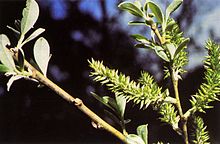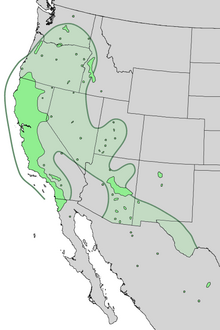bio.wikisort.org - Plant
Salix lasiolepis (arroyo willow) is a species of willow native to western North America.[2]
Distribution
The core range of the arroyo willow includes most of California, including the California Coast Ranges, Arizona, Klamath Mountains, Peninsular Ranges, Sierra Nevada, and Transverse Ranges.[3] It extends north into Washington, south into Baja California, and east into Idaho, Utah, Texas, and Coahuila (México).[2][4]
Habitat
The plant is commonly found growing in riparian zones in canyons and valleys, along pond shores, and in marshes and wetlands.[5] It is found in many plant communities, including: chaparral, oak woodland, mixed evergreen forest, coast redwood forest, yellow pine forest, red fir forest, lodgepole pine forest, and grasslands.[3]
Allergenicity
Arroyo Willow (Salix lasiolepis) is a severe allergen.[6]
Pollination
Occurs in following seasons depending on latitude and elevation: Spring.
Description
Salix lasiolepis is a deciduous large shrub or small multi−trunked tree growing to 10 metres (33 ft) tall. The shoots are yellowish brown and densely hairy when young. The leaves are 3.5–12.5 centimetres (1.4–4.9 in) long and broadly lanceolate in shape. They are green above and glaucous green below. The undersides are covered with whitish or rusty hairs which gradually wear off during the summer.
The flowers are arranged in yellow catkins 1.5–7 centimetres (0.59–2.76 in) long which are produced in early spring. The bloom period is February to May.[3]
Varieties
- Salix lasiolepis var. bigelovii — Bigelow's willow, endemic to California and Oregon.[7] Currently reclassified as species Salix lasiolepis.[8][9][10]
- Salix lasiolepis var. lasiolepis — Tracy Willow, endemic to narrow Pacific coastal zone in NW California and SW Oregon.[11][12][4] Currently reclassified as species Salix lasiolepis.[8][13][14]
Uses
The indigenous peoples of California used the species in various ways. As a traditional medicinal plant, infusions of the leaves, bark, or flowers were used for several disease remedies. The inner bark was used to make rope. Shoots were used in coiled and twined basketry, and branches were used to make acorn storage baskets.[15]
References
- Stritch, L. (2018). "Salix lasiolepis". IUCN Red List of Threatened Species. 2018: e.T126589815A126591075. Retrieved 22 February 2022.
- USDA: Salix lasiolepis
- Calflora: Salix lasiolepis
- Little Jr., Elbert L. (1976). "Map 174: Salix lasiolepis". Atlas of United States Trees. Vol. 3 (Minor Western Hardwoods). US Government Printing Office. LCCN 79-653298. OCLC 4053799.
- Salix lasiolepis Shrubland Alliance California Native Plant Society. Retrieved 24 April 2019.
- Arroyo Willow (Salix lasiolepis) Retrieved 24 April 2019.
- USDA: Salix lasiolepis var. bigelovii
- ITIS Salicaceae of North America Update, database (version 2011)
- ITIS: Current name of Salix lasiolepis var. bigelovii. accessed 22 March 2016.
- Jepson eFlora: Current name of Salix lasiolepis var. bigelovii . accessed 22 March 2016.
- NPIN: Salix lasiolepis var. lasiolepis
- USDA: Salix lasiolepis var. lasiolepis
- ITIS: Current name of Salix lasiolepis var. lasiolepis. accessed 22 March 2016.
- Jepson eFlora: Current name of Salix lasiolepis var. lasiolepis. accessed 22 March 2016.
- University of Michigan at Dearborn: Native American Ethnobotany of Salix lasiolepis
External links
 Media related to Salix lasiolepis at Wikimedia Commons
Media related to Salix lasiolepis at Wikimedia Commons Data related to Salix lasiolepis at Wikispecies
Data related to Salix lasiolepis at Wikispecies- Lady Bird Johnson Wildflower Center−NPIN database
- Salix lasiolepis in the CalPhotos photo database, University of California, Berkeley
- "Salix lasiolepis". Calflora. Berkeley, California: The Calflora Database.
- "Salix lasiolepis". Plants for a Future.
На других языках
- [en] Salix lasiolepis
[es] Salix lasiolepis
Salix lasiolepis (en español: sauce de los arroyos, en inglés: arroyo willow, en náhuatl: quetzalhuexōtl) es una especie dentro del género Salix nativo del oeste y suroeste de Norteamérica, en los Estados Unidos desde el sur de Washington y suroeste de Idaho hasta el sur de California y Texas, y en México desde Baja California a Coahuila por el este y Jalisco por el sur. Se encuentra en barrancas, en las orillas de las charcas y en humedales.[1][2]Другой контент может иметь иную лицензию. Перед использованием материалов сайта WikiSort.org внимательно изучите правила лицензирования конкретных элементов наполнения сайта.
WikiSort.org - проект по пересортировке и дополнению контента Википедии



